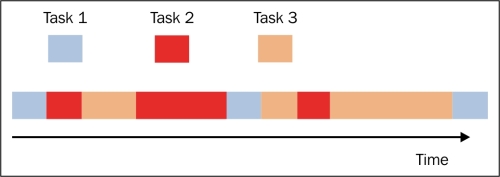With the sequential and parallel execution model, there is a third model, called the asynchronous model, that is of fundamental importance to us along with the concept of event programming. The execution model of asynchronous activities can be implemented using a single stream of main control, both in uniprocessor systems and multiprocessor systems.
In the asynchronous model of a concurrent execution, various tasks intersect with the timeline, and all of this happens under the action of a single flow of control (single-threaded). The execution of a task can be suspended and then resumed, but this alternates the time of other tasks. The following figure expresses this concept in a clear manner:

Asynchronous programming model
As you can see, the tasks (each with a different color) are interleaved with one another, but they are in a single thread of control; this implies that when one task is in execution, the other tasks are not. A key difference between the multithreaded programming...



